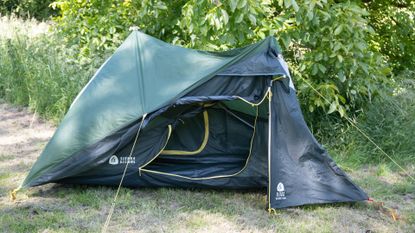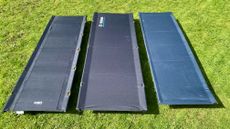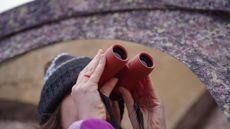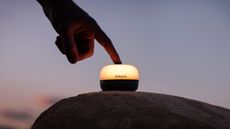If you're shaving off the grams and going ultralight with your camping setup, you're probably on the hunt for a tent that will pack down small and add as little weight as possible to your backpack. If so, Sierra Designs' High Route 1 3000 one-person tent (£274.99) has your name on it for solo adventures – this sub-one kilo design does away with poles completely, instead using two trekking poles to create a sturdy three-season structure. So how does the European model of this innovative tent, launched in 2022, perform on test for travelling light? Has it earned a place amongst today's best backpacking tents? Here's my Sierra Designs High Route 1 3000 1P tent review.
Sierra Designs High Route 1 3000 1P tent review: design and features
Sierra Designs High Route 1 3000 specs
Size: 259 x 107cm
Weight: 898g
Capacity: 1-person
Bedrooms: 1
Porches: 2
Seasons: 3
Pitch time: 10 minutes
The first thing you'll notice about the Sierra Designs High Route is how little of it there is. This tent packs down into an impressively small stuff sack that's about the size of a loaf of bread and weighs just 898kg. Inside, there's a flysheet, a separate inner tent, ten pegs – and that's it.
Wondering where the metal poles are? The Sierra Designs High Route doesn't have any – instead, this innovative design uses two standard trekking poles to hold everything aloft. The High Route can be pitched as a full tent, as just the inner tent as just the flysheet if you need some quick protection from the rain on a bivvy bag camp. Trekking poles are slotted into opposing corners of this asymmetric design, pulling the tent taught.
Inside, there's a bedroom that's roomy for one person with a backpack (but definitely too small for two). A small mesh pocket (I'd have liked more) plus hanging tabs for clothing or a lantern will help you get organised. There are also two porches, which are handy for storing wet kit or for stashing muddy hiking boots. The inner tent's main body and doors are lined with unzippable 'no see um' mesh, to keep biting insects at bay, and a small vent helps with air flow. The neutral green shade of the High Route is ideal for wild camping, as it blends in nicely with the landscape.
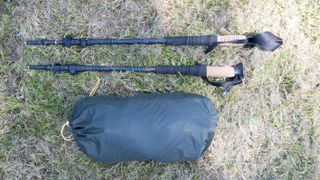
Sierra Designs High Route 1 3000 1P Tent review: pitching and living space
Unpack the Sierra Designs High Route 1, grab two trekking poles and you're ready to pitch this simple tent. Well, theoretically. On test I did find it took a bit of practise to get the High Route looking right, as there are limited instructions included and it takes a knack to use the trekking poles instead of traditional metal poles. The trick is to take two adjustable trekking poles, set them to a low height, insert them into pockets in the roof of the High Route's outer flysheet and then lengthen each pole to create tension.

I found that when using cheap and flimsy trekking poles, the High Route didn't really stand up properly. On my next go I used higher-quality trekking poles and worked at getting them set at the right angle, and this time I ended up with solid structure. The second step is easier – pop inside the flysheet and clip the separate inner tent to it using the obviously placed clips. You'll also need to master pegging the tent out tightly at the right angles, to get a taught flysheet that doesn't sag.
Once you've had a go a few times, you can erect the High Route easily in 10-15 minutes. I definitely found it harder than traditional poled tents, though, and I'm not sure I'd agree with Sierra Designs that this is a ‘simple, intuitive' pitch. The good news is that breaking camp is the work of just a few minutes, and I really rate the stuff sack that comes with the tent – it's quick and easy to pop all the parts back in and chuck it in your backpack in seconds.

Sierra Designs High Route 1 3000 1P Tent review: out in the elements
Once successfully pitched, the High Route offers a good amount of living space for one. Inside this tent feels airy, with room to sit up and move around (unlike some coffin-like ultralight designs), and plenty of headroom. I loved the two wide porches, which make travelling with lots of kit on multi-day hikes much easier. I tested the High Route out in Wales on a rainy night and was perfectly dry – and the big gap between the flysheet and the inner tent means you don't have to worry if kit is pressed against the sides of the inner tent.
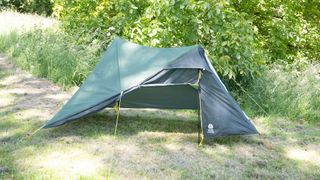
The groundsheet feels tough, and should withstand use on uneven ground. The vent and that generously-spaced design are also effective at keeping air flowing and you cool on hot summer mornings. The ability to pitch just the flysheet is great, too – if it's chucking it down, you and your kit can have a dry shelter ready to use in just a few minutes. The tent also dries in a matter of minutes if you have to pack it down while wet. And if it's a lovely summer's night, you could sleep in just the inner tent, and get to do some stargazing without worrying about midges and mosquitoes getting in.
On the whole, I liked the no-poles approach of the High Route tent, although it does limit it to a specific audience – you'll need to be someone who is headed off hiking (rather than say, bike packing or just going on a camping holiday) and who uses trekking poles for every trek (I only take mine on more challenging routes, for example). While there is a pole set available to buy separately for this tent, that sort of defeats the point of the High Route – I'd only recommend it to someone who already uses their own trekking poles and wants a tent for fast and light adventures on foot.
Sierra Designs High Route 1 3000 1P Tent review: alternatives to consider
If you're aiming for lightweight and easy to pack but don't mind the extra weight of poles, I'd recommend the same brand's Meteor Lite 2 (read my Sierra Designs Meteor Lite 2 tent review), which offers room for two people. Also check out my Sea to Summit Alto tent review – that one packs down into three separate small stuff bags for easy packing, or for sharing between two people.
Sierra Designs High Route 1 3000 1P Tent review: verdict
Small but mighty, Sierra Designs' High Route 1 is perfect for a trekking-savvy solo hiker who wants to keep kit as lightweight and easy to pack as possible without compromising on quality or living space. The innovative trekking poles-as-tent-poles design works well once you've got the hang of it (but only if you're using decent poles!), and once erect, this tent feels like good quality, with spare room for storage and a reliably waterproof but breathable living space. Pitching the flysheet or the inner tent on their own is an added bonus for versatile sleeping setups.
